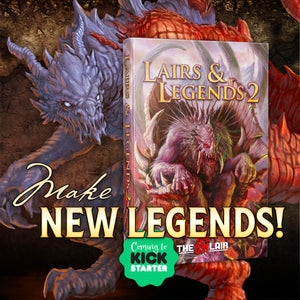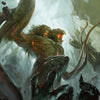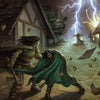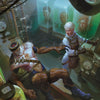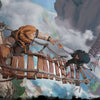Top 8 Adventure Design Mistakes in D&D (and what to do instead)

By Luke Hart
Designing great Dungeons & Dragons dungeons isn’t just about stringing together rooms full of monsters and traps—it’s about building adventure locations that feel alive, with purpose, pacing, and stakes. Unfortunately, too many D&D dungeon crawls fall flat because they ignore the fundamentals of engaging dungeon design. Whether you’re crafting a classic underground crypt, a ruined temple, or a feywild stronghold, the same core mistakes crop up again and again—and they’re ruining your players’ immersion.
In this article, we’ll cover the biggest dungeon design mistakes that derail D&D games and how to fix them. If you’ve ever watched your players lose interest halfway through a dungeon, this guide is for you. From setting clear goals and stakes, to creating meaningful encounters, adding foreshadowing, and giving your dungeons actual purpose, these tips will help you create memorable, story-rich environments for any TTRPG campaign. Stop designing boring dungeons—and start building locations your players can’t wait to explore.
By the way, if you're looking for a low level pre-made adventure module for your D&D 5e game, I highly recommend Into the Fey. It's designed for levels 1 to 5, features tricksy fey and their sly schemes, and contains everything you need to play!
Watch or listen to this article by clicking the video below.
PROBLEM 1: The Dungeon That Doesn’t Matter
So, we were crawling through a ruined temple full of cursed statues and reanimated priests. Cool setting, solid monsters. But something just felt… off.
Halfway through the crawl, one of the players said, “So, wait. What is this place?” The table went quiet. I shrugged. They shrugged. We kept playing.
That’s a problem.
A dungeon without purpose is just a pile of rooms.
If your players don’t know what the dungeon used to be, who built it, or why it’s there now, you’ve missed a huge opportunity. Dungeons don’t need walls—well, actually they do, BUT, they also need context. Was it a prison? A temple? A wizard’s private pantry?
Even if it’s been taken over by monsters, give players a sense of history. Let them find clues—inscriptions, murals, broken furniture. Make them wonder what happened here. And tie those clues into the monsters that live there now. A dungeon with no story is just a slow-motion combat encounter.
PROBLEM 2: Nothing Makes Sense
One time, I played through a dungeon that had a demon, a giant spider, a vampire, and a gelatinous cube—in that order. No transitions. No themes. Just vibes—whatever that means.
It felt like a random encounter table had been dropped into a hallway or series of rooms.
Dungeons should have a cohesive theme. That doesn’t mean every monster needs to be the same type, but there should be a sense of internal logic. A fire cult’s lair might include salamanders, fire traps, and ash-covered murals. A dungeon built by fey might use illusions, sleep spells, and mirrors.
If your dungeon has multiple environments—say, an icy cave leading into a dwarven ruin—build transitional spaces that blend the themes. Frozen stonework. Abandoned forges buried in snow.
Your goal is to make the dungeon feel like a place that exists, not a grab bag of encounters. Pick a theme. Reinforce it with monsters, hazards, descriptions—even the rules you emphasize at the table.
PROBLEM 3: It’s Just a Combat Gauntlet
I once ran a dungeon where every single room was a fight. Room, initiative, kill, loot, move on. It was like watching someone button-mash through an RPG boss rush. No tension. No mystery. Just fatigue.
A good dungeon is more than just combat—it’s all three pillars of play: combat, exploration, and social interaction.
Even in a classic dungeon crawl, you need to give players a chance to interact with the environment. Add puzzles. Add strange magical phenomena. Add weird NPCs—ghosts, trapped creatures, neutral monsters with their own goals. What the heck is a TRAPPED creature, by the way?
And most importantly, add rooms without combat. Let players explore. Let them speculate. Let them breathe.
Because if your dungeon is just “fight, fight, fight,” players will stop caring—especially when the fights all start to feel the same.
PROBLEM 4: No Place to Rest
We were five rooms deep, running low on spells, and one player said, “Let’s short rest.” Not that that would help with the spell problem, but bless his heart, he was trying. Anyway, I looked at the map. There was nowhere safe. The next room was full of undead, the previous one was still on fire, and the hallway was a death trap.
They hated it. And I couldn’t blame them.
Longer dungeons—especially multi-session ones—need safe spaces. These are called rest nodes or refuges, and they give players a strategic option. Do we push forward? Do we risk resting here?
It doesn’t have to be a cozy inn. Maybe it’s a locked room. Maybe it’s a zone blessed by a forgotten god. Maybe it’s a place the monsters avoid.
But whatever it is, give your players breathing room. Let them regroup. Because dungeons aren’t supposed to be a single endurance check—they’re supposed to be tactical puzzles, and that means knowing when to rest is just as important as knowing when to fight.
PROBLEM 5: No Foreshadowing
The final boss was a red dragon.
We’d spent the whole dungeon fighting goblins and traps, and then—surprise! Dragon. The players were confused, unprepared, and honestly kind of annoyed.
If your dungeon has a boss—or a twist—it needs foreshadowing.
This is one of the easiest tools in a DM’s belt. You don’t have to tell them what’s coming. Just hint. Burn marks on walls. Huge claw gouges. A survivor mumbling about wings and fire. Let the players piece it together.
Foreshadowing builds tension. It lets players prepare. It rewards them for paying attention. And it makes the final encounter feel earned.
Surprise can be fun—but it’s almost always better when players get to anticipate the danger before it arrives.
PROBLEM 6: No Goal, No Stakes
I’ve played dungeons where the party was told to “go clear it out.” That’s it. No real reason. No reward. No time pressure. Just wandering from room to room, killing things because the DM said so.
It’s boring. And players feel it.
Your dungeon needs a goal. Rescue a hostage. Retrieve an artifact. Stop a ritual. Something. Anything. Because without a goal, the adventure doesn’t feel like a story—it feels like a checklist.
And good goals come with stakes. What happens if the players fail? What happens if they take too long?
Even something as simple as “save the villagers before nightfall” adds urgency. Give the dungeon meaning beyond “it’s full of monsters.” Make the players care about what’s inside—and what happens when they leave.
PROBLEM 7: Bad Traps
I hate to say it, but some of you are still using “step on a plate, take 2d10” as a trap.
We can do better.
Traps should be part of the gameplay, not just random damage. Let players notice them. Let them figure out how to bypass them. Let them fail in interesting ways.
The best traps are like puzzles. They have clues. They make players stop and think. They make them paranoid. A hallway filled with dart holes is way scarier than one that just triggers damage with no warning.
Also, mix it up. Use magical traps. Social traps. Environmental traps. Make traps that fit your dungeon’s theme and make the players feel clever when they survive them.
Because a good trap is memorable. A bad one is just wasted time and lost hit points.
PROBLEM 8: The Lame Ending
We cleared out the dungeon. No boss. No treasure. No story. Just… the last room was empty. The DM said, “That’s it.” And we packed up.
It was like watching a movie that ends mid-sentence.
Your dungeon needs a payoff. Not just loot—but something to mark the climax. A major encounter. A dangerous puzzle. A moral choice. Something that ties back to the dungeon’s theme and gives players closure.
A boss fight is great, but it’s not the only option. Maybe the dungeon is collapsing. Maybe the artifact corrupts the wizard. Maybe the party finds a prisoner who knows too much.
The point is—don’t let your dungeon end with a whimper. Let it end with a bang. Something that makes the players sit back and go, “Well that was cool.”
Confront Devious Fey and Their Tricksy Plots!
For years, the fey creatures inhabiting Pelview Grove to the north and Pelfell Bog to the east have not been a source of trouble, though perhaps they were a shade too mischievous at times. That has now changed.
Beset on all sides by a variety of issues -- childish pranks gone wild, dwarves forced out of their own brewery, and farmers missing -- the Aeredale guard is looking for help from local adventuring parties to set things right.
For those brave souls who accept the call to adventure, it'll be time to go into the fey.
If you’re looking to start up a new 5e campaign or reboot your current one, Into the Fey may be exactly what you need. Designed for levels 1 to 5, Into the Fey contains everything you need to start playing:
- Eleven fey-themed adventures for level 1 to 5 adventuring parties
- Over 40 new fey monsters
- The fully fleshed-out town of Aeredale
- Maps of Aeredale, the surrounding region, and the Fey Plane
- Player handouts
- Hag potion system
- 15 new fey magic items
- JPG image files of all Into the Fey adventure maps, including GM versions and gridded/non-gridded player versions
- JPG images files of all Into the Fey world maps
- Digital tokens of Into the Fey NPCs and monsters
Pick up the Into the Fey Ultimate Bundle to get the hardcover, the PDF, digital maps, and digital tokens.
Starting a new campaign can be tons of work; let Into the Fey do some of the heavy lifting for you!
-
Posted in
Game Master How-To Articles


